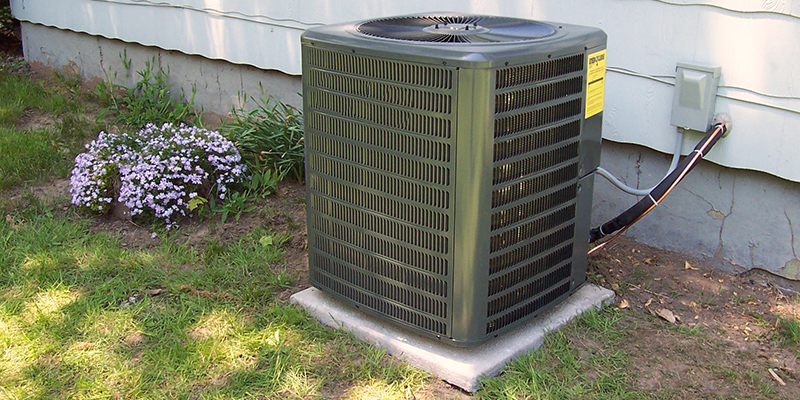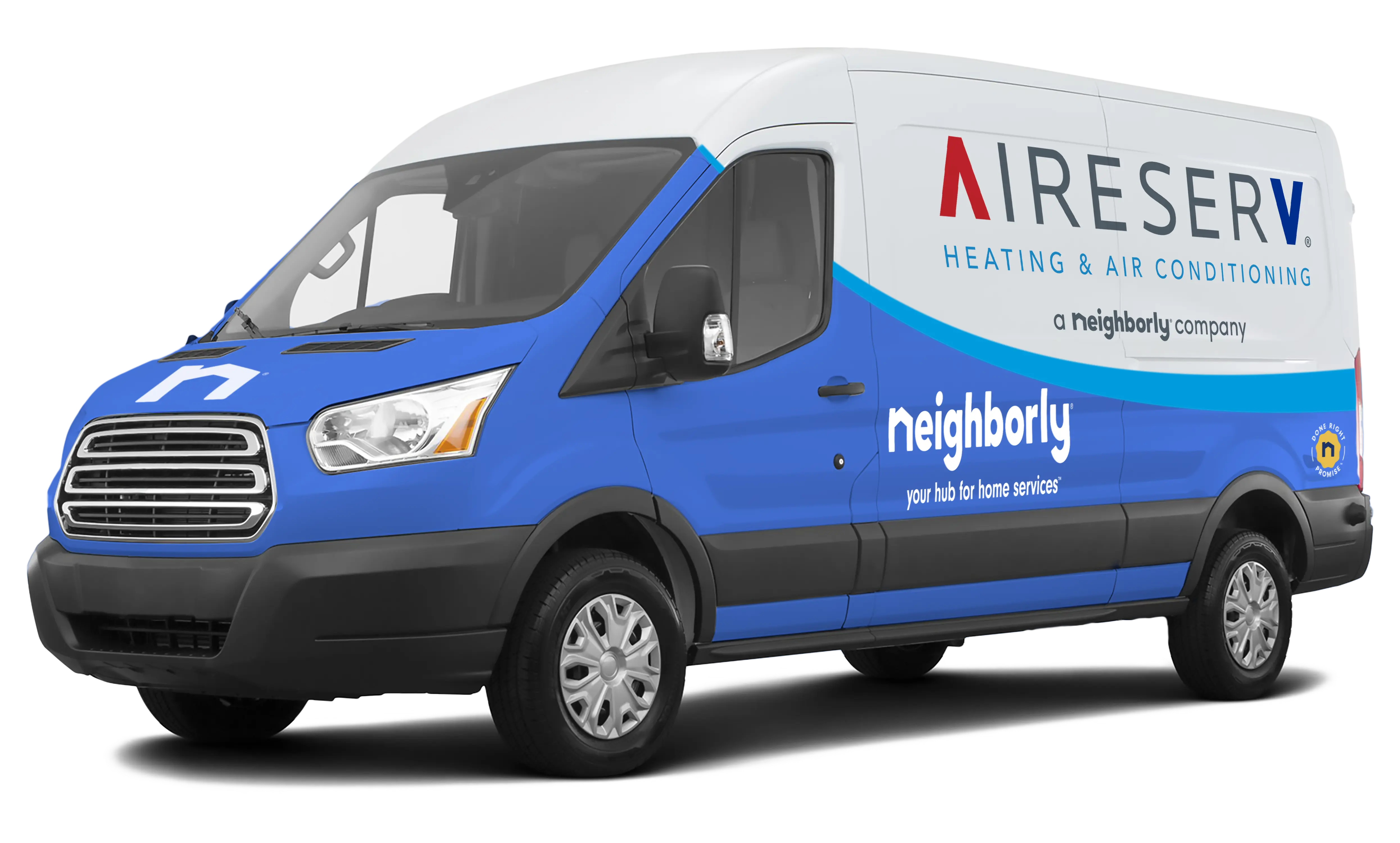
To find your AC unit’s tonnage, Aire Serv recommends these steps.
- Locate the manufacturer’s label on your outdoor condenser.
- Identify the model number, often containing a two-digit number divisible by 12 (e.g., 24, 36, 48).
- Divide this number by 12 to determine the tonnage.
- Consult Aire Serv for expert assistance if needed.
Just have a couple of quick questions? Jump to quick AC troubleshooting FAQs
Are you in the market for a new air conditioner? If your unit has stopped working effectively, you may be ready to replace it. Before making a purchase decision on a unit, you’ll need to determine the best size for your home. This is essential for both efficiency and savings. A unit that's too big or small will not heat or cool your home efficiently and will cost you more to operate. Therefore, finding a unit that is correctly sized for your home is essential. HVAC systems are sized according to their tonnage, which may lead you to ask how to find tonnage on an AC unit. The answer can help guide your search for a replacement system. After all, AC tonnage describes cooling capacity, which is something you’ll definitely want to understand as you shop for a new unit.
How to Find AC Unit Tonnage
Knowing where to start when searching for a replacement air conditioner can be difficult. You may find yourself asking what size AC unit you need. You may find the answer on your current unit. Find your condensing unit and search for a data plaque or sticker on the side. You should see a model number and a string of numerals and letters. There should also be an even, two-digit number – which indicates the AC tonnage of the unit. This number is typically between 18 and 60. Divide this number by 12 (representing 12,000 BTU/hr, or one ton of cooling capacity) to get the overall tonnage of the unit. This chart may also be useful when converting the numbers:
- 18 = 1.5 tons
- 24 = 2 tons
- 30 = 2.5 tons
- 36 = 3 tons
- 42 = 3.5 tons
- 48 = 4 tons
- 60 = 5 tons
What is AC Unit Tonnage?
Heating and cooling capacities are measured using British thermal units (Btu) per hour. One Btu equals the heat generated by a single candle. It’s the amount of heat required to raise the temperature of one pound of water by one degree.
AC unit tonnage describes the cooling capacity of your air conditioner. One ton of cooling is the rate of heat transfer required to freeze 2,000 lbs – or one ton – of water over the course of 24 hours. This equals 12,000 Btu per hour.
Why is AC Unit Tonnage Important?
When it comes to sizing AC units, more tonnage is not necessarily better. While you might be tempted to invest in the biggest unit available, this may overwhelm your space, raise your energy costs, and decrease energy efficiency. Short cycling often leads to increased wear and tear, causing a shorter overall lifespan for the unit. Short cycling also prevents dehumidification, leaving your space cool but clammy. Turning the temperature down might help, but this raises your electricity usage and overall energy costs.
Bigger air conditioners cost more to purchase and operate. Of course, you don’t want to go too far in the other direction, either. Undersized units may struggle to cool your space effectively, especially on hot summer days. A system that is too small for your space will run more frequently, causing more wear and tear and increased repairs. So finding the optimal size unit for your space is the key to energy efficiency and performance.
What Size AC Unit Do I Need?
You’ve answered the question: how to find tonnage on an AC unit. Now what? Tonnage is just one factor to keep in mind as you shop for a replacement. Your new unit shouldn’t necessarily have the same tonnage. If you’ve made improvements to your space since you last installed your air conditioner, you may not need as powerful a unit. Conversely, if you’ve added onto your home and increased your square footage, you may need more cooling power. It’s also possible that your existing unit was never properly sized for your space to begin with, and therefore, you’ll need to adjust the size of the new unit accordingly.
While AC unit tonnage can be helpful to know, it’s important to keep other features in mind. There are three main types of air conditioners, all of which cool using similar methods. Before shopping for a replacement, consider how you like your existing system. Whether you have a ductless AC, packaged air conditioner, or split-system air conditioner, you’ll want to maximize your comfort and system efficiency with your next upgrade.
Factors Beyond Square Footage
While square footage is an important factor to keep in mind when replacing your air conditioner, it’s far from the only consideration. If your home is especially shaded or receives a lot of sun, you may need less or more AC unit tonnage. The number of occupants also impacts your unit’s ability to cool your space. The location also plays a role – if you’re mounting your air conditioner near the corner of a room, you’ll want a unit that sends airflow in the right direction.
It’s easy to feel overwhelmed by the possibilities. Your local Aire Serv professionals are happy to walk through the options with you and help you understand how to read the tonnage of an AC unit.
Call Aire Serv® for Help Sizing Your Air Conditioner
If you’re confused about what tonnage AC you need, allow Aire Serv® to help you figure it all out. Our team of professionals can help you find the correct size for your space and guide you through a number of high-quality options. If efficiency is a top priority, we can review some cost-effective solutions when upgrading your system. Once you decide on a particular unit, we’ll install it to ensure maximum performance. Trust Aire Serv to help you through every step of your AC upgrade – schedule your appointment online today or call us!
This article is intended for general informational purposes only and may not be applicable to every situation. You are responsible for determining the proper course of action for your home and property. Aire Serv is not responsible for any damages that occur as a result of this blog content or your actions. For the most accurate guidance, contact the Aire Serv location nearest you for a comprehensive, on-site assessment.
How To Figure Out AC Tonnage Frequently Asked Questions
30+ years in the HVAC business have taught us a lot, including the importance of sharing our knowledge and experience to answer your questions about HVAC service. Here are answers to some of the frequently asked questions about how to figure out AC tonnage.
What does AC tonnage mean and what does it measure?
Many customers ask us, “What does the term ‘AC tonnage’ mean?” In air conditioning, “tonnage” is a unit of measurement describing the cooling capacity of a system. It has nothing to do with the physical weight of the unit!
One ton of AC capacity is defined as the amount of heat an air conditioner can remove from a space in one hour, equivalent to roughly 12,000 British Thermal Units (BTUs). This term originates from a time when ice was the primary means of cooling a space. One “ton” of cooling capacity is roughly equivalent to the amount of heat needed to melt one ton of ice in 24 hours.
For example, a 2-ton AC unit can remove 24,000 BTUs of heat per hour, while a 5-ton unit can remove 60,000 BTUs per hour. The tonnage of an AC system is a significant factor in determining its ability to cool a specific area effectively.
Selecting the correct tonnage for a space ensures optimal comfort and energy efficiency. An undersized unit will struggle to cool the area, while an oversized unit may cycle on and off too frequently, leading to discomfort and potential energy waste. If you’re tired of asking, “What ton AC unit do I need?” Aire Serv professionals can provide the answer. Our experts will ensure you have the right AC unit for your residential or commercial space.
How to find tonnage on my AC unit?
Home and business owners wondering how to find AC tonnage can rely on Aire Serv. Our service professionals can show you how to determine AC tonnage from the model number of your unit.
First, find your condensing unit, which is the outdoor component of a split-system air conditioner. It's typically a box-shaped metal cabinet situated outside your house or building, often on a concrete pad. You'll usually find it on the side or rear of the property.
There should be a plaque or sticker on the side with a model number displayed. The tonnage of your AC unit should be shown in or near the model number as an even, two-digit number between 18 and 60—this indicates the BTU capacity of your unit. Divide this number by 12 to find the A/C ton capacity. For example, if you own a Trane brand AC unit with model number 4TTZ0048A1000AA, 48 is the number you want (indicating your AC unit moves 48,000 BTUs an hour). Divide 48 by 12, and you have a 4-ton AC unit.
Many brands encode the AC tonnage in the model number in a similar way. You can also complete an air conditioner model number lookup by searching for your model number online. If you are unsure of where to find the AC tonnage of your unit or have additional questions, contact Aire Serv.
How many BTUs are in a ton?
One ton of AC capacity is equivalent to 12,000 British Thermal Units (BTUs) per hour. A BTU is a unit of energy, specifically the amount of heat required to raise the temperature of one pound of water by one degree Fahrenheit.
In the context of air conditioning, the BTU rating indicates the amount of heat the unit can remove from a room in one hour. Therefore, a 1-ton AC unit can remove 12,000 BTUs of heat from your space every hour. This conversion is fundamental in sizing air conditioning systems for effective cooling.
What tonnage air conditioner do I need?
Your AC tonnage needs depend on your usage. The most accurate method to determine air conditioner size for a given space involves a Manual J load calculation. This comprehensive assessment, typically performed by HVAC professionals, considers various factors beyond just square footage.
Variables considered in the Manual J load calculation include the home's insulation levels, the number and size of windows and doors, the direction the house faces, the local climate, the number of occupants, and the effects of other heat-generating appliances. This detailed analysis calculates the precise heating and cooling loads in British Thermal Units (BTUs) required for the space.
While a rough estimate can be obtained by multiplying the square footage by a general BTU factor (often around 20 BTUs per square foot for cooling, varying by climate), this method is less reliable.
Online BTU calculators can offer a more refined estimate by factoring in some of the variables mentioned above. However, for optimal sizing and performance, a professional Manual J calculation is highly recommended. This ensures the selected system meets the specific needs of your home, providing consistent comfort and efficient operation.
How to determine the size of a heating and air conditioning system?
To determine the size of your heating and air conditioning (HVAC) system, look at the data plaque or sticker on the condensing unit, which is typically outdoors near your building. There should be a model number as well as a two-digit even number between 18 and 60, which indicates the tonnage of your unit (this number may also be embedded in the model number).
This information can be helpful when scheduling maintenance and repair of your HVAC unit. If you’re unsure about sizing or want to schedule a professional inspection, contact your local Aire Serv team. We offer 24/7 customer service and are more than happy to answer all your questions about residential air conditioning repair services or commercial air conditioning repair.
Is the physical size of the outdoor unit an indicator of its tonnage?
Not necessarily. While larger units might have higher tonnage, size is not a reliable way to determine capacity. Always check the date plaque or sticker, search for the model number, or call a professional to learn more about how to find the tonnage of an AC unit.
Can I replace my old AC with a unit of the same tonnage?
You may be able to replace your old AC with a new unit of the same tonnage, but this is not always the case. Changes to your home (such as insulation upgrades or new windows) or inaccuracies in the original sizing might mean a different tonnage is now appropriate.
If you’re considering replacing your AC unit, contact your local Aire Serv first. We’ll evaluate your unit and determine if maintenance, repair, or replacement is needed. Our trustworthy and honest experts are backed by the Neighborly Done Right Promise® to ensure your satisfaction.

